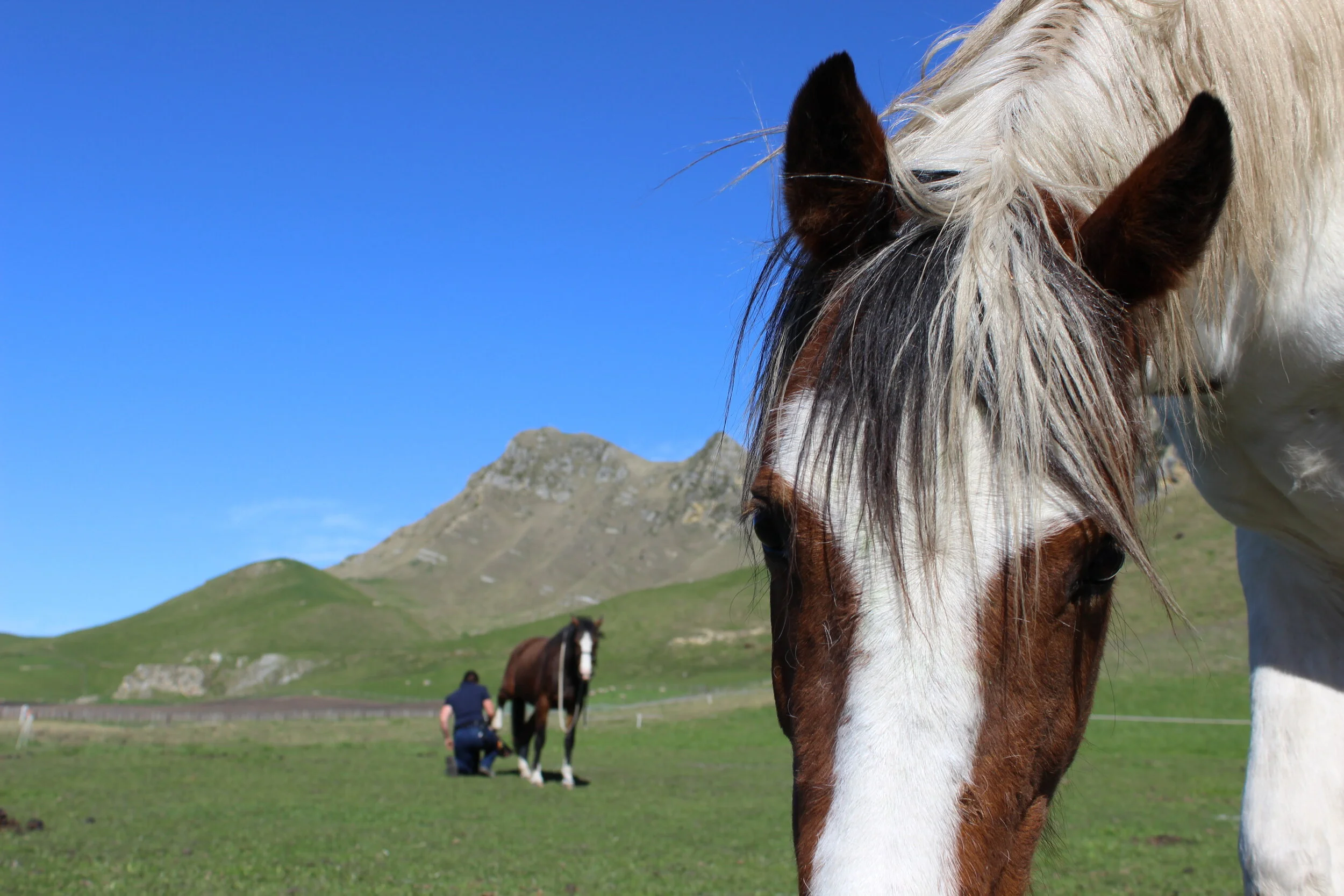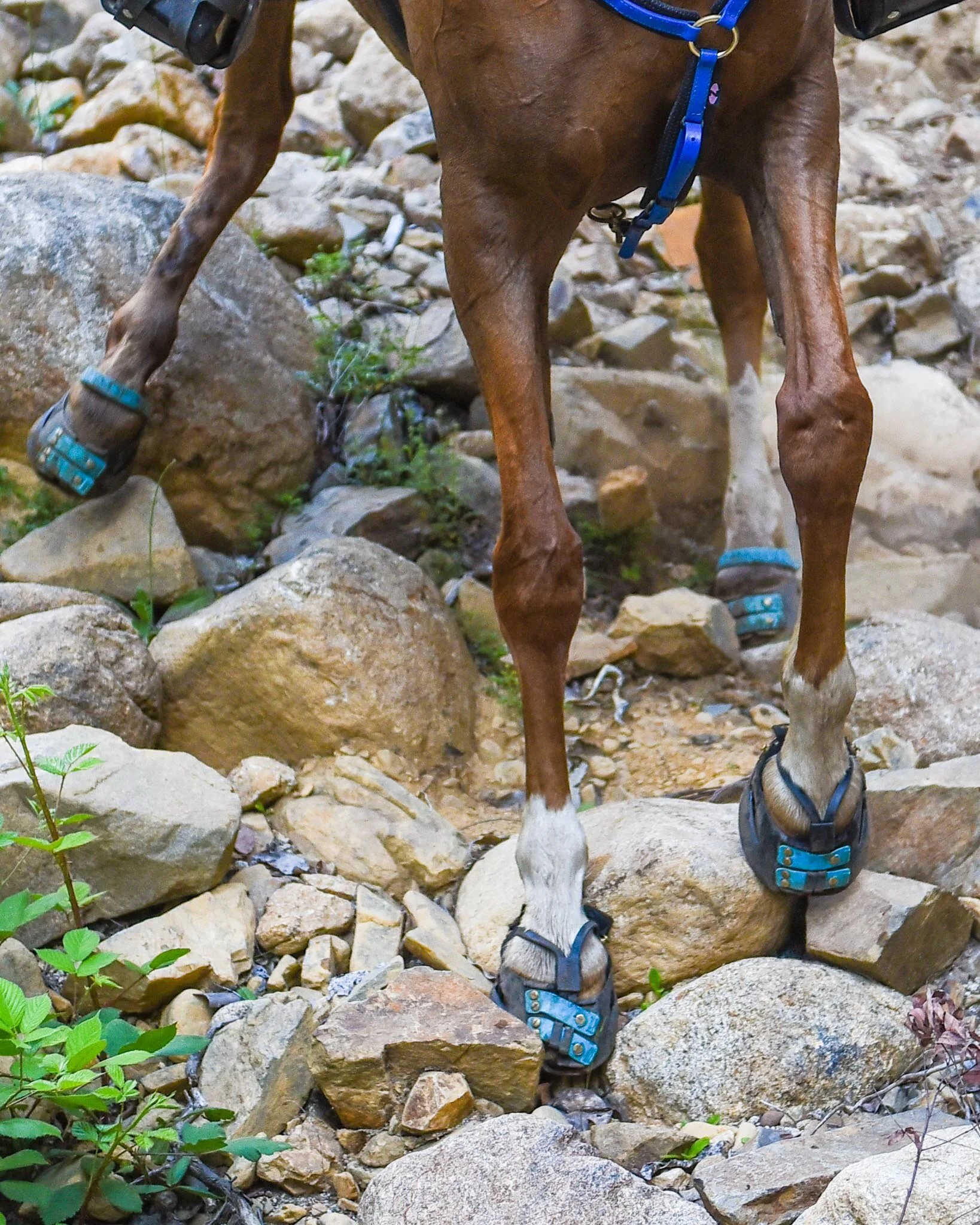Equine Podiatry
I don’t identify as a farrier, but I also don’t like to call myself a barefoot trimmer! My qualification is in Equine Podiotherpy, and I think that is about right! I am a podiatrist for horses, I seek to develop and build the best hoof possible for each horse to support their body for healthy posture and biomechanics. That might be barefoot, or booted or it maybe glue-on composite shoes.
What’s the problem with metal shoes?
Well firstly, we should perhaps thank the humble metal shoe. Without the fact that you can nail a metal shoe to the living structure of an equine foot, our society would not look the same as it does today. There is no other creature that has a foot that you could nail to, giving them the ability to live in less than ideal conditions, cross rugged terrain and carry and pull humans and our things. Would horses even be with us if we had not been able to nail a shoe onto them? Possibly not.
So what’s the big deal? The metal horseshoe got us this far, right?
In days of old the blacksmith would recommend that you “give your horse’s feet a chance to recover from the shoes in the off season”, you would shoe your horses when necessary and then pull the shoes and turn the horse out. It was well recognised how shoes would distort the structures of the horse’s foot, but that they were needed for the horse to work.
Images by Bracy Clark (1827) an English veterinary surgeon specialising in the horse.
Fast forward to now, and our equine world has no off season! We ride and compete all year round and so many horses are shod all year round, hooves never get a chance to recover. We see many of the distorted hooves in the diagrams above, and these horses don’t cope well without shoes! Shoes are kept on so the horse can stay in work, and the distortions and dysfunction progresses.
Aside from distortion caused by overuse, the main is with traditional horseshoes is the material - steel. Putting rigid steel onto a living structure creates a lot of concussion, while minimising the hoof’s ability to absorb concussive forces, by retarding the hoof’s ability flex and expand.
Can you imagine what wearing steel shoes, would do not just to your feet, but to your whole body? If you had a weak foot, that got sore loading and flexing, it may well be an improvement to start off with, but over time your foot would weaken and atrophy further, it would change the way you moved and put more force on your joints and soft issue, creating some serious long term issues.
The thing is though, it’s not always that black and white. Poor, trimming and lifestyle can have the same affect on hooves as constant shoeings. And shoeing, when used as a tool, with breaks when possible, is not evil!
How is a Barefoot trim different?
Bare hoof care seeks to mirror the way the horse naturally wears down their own feet, and has some key differences to a “pasture trim” (probably named because riding horses “need” shoes, if the horse is going with out shoes it will just be in the pasture!).
Pasture Trim:
The hoof is trimmed as if to nail on a shoe, but then left bare.
The ground bearing surface of the hoof is completely flat.
The weight is concentrated on the hoof wall, including the inner and outer hoof wall, which has a square edge.
The trim cycle is usually 6-8 weeks, sometimes longer.
Barefoot Trim
The trim seeks to mimic the way the horse would wear his own hooves given enough movement.
The ground bearing surface is curved, following the arch of the sole.
The weight is shared over the inner hoof wall, white line, peripheral edge of the sole and the frog. The outer hoof wall is rounded away.
The trim cycle is is shorter and more regular to keep the hoof in a more consistent balance.
Not all “barefoot trims” are equal, just as not all shoeing jobs are equal. There are many different styles and schools of thought around both trimming and shoeing. The best thing you can do for your horse is to expand your own knowledge and ask questions.
What is “modern” or “Functional” Hoofcare?
We have learnt so much about the equine hoof in the last few decades, there have been many studies, new methods tried and new technologies created. I believe the way forward in hoofcare is to use the new knowledge that the “barefoot movement” has created, respect the natural form and function of the hoof, and use new technologies to protect and rehab hooves as needed.
Healthy bare hooves can perform in almost any discipline and terrain we throw at them, but most often our domestic hooves are not up to this standard. The equine hoof is designed to work, it flexes, expands, contracts and stretches. The inner structures that we don’t see and often forget about, are just as important as the outer structures. Just like any other part of the body it needs to work, receive good nutrition, and be well balanced in order to be healthy and functional.
The performance of our horse’s feet in domestication is affected by:
The environment we keep them in. Often in NZ this is a grass paddock, but in order for the hoof to perform well on any terrain, the horse needs to be moving over varied terrain all the time.
The horse’s nutrition. The domestic horse’s diet is often full of sugar and unbalanced minerals. The health and function of the bare hoof is reflected in the horse’s over all and gut health.
How much the horse moves. Use it or loose it! The equine and their hooves are designed to travel many kilometers per day, movement builds the hoof, but our domestic horses often get an hour of work then stand around for the day.
The horse’s upbringing. Hooves are developing from the moment the new born foal stands up, lots of movement over varied terrain builds strong, healthy tissue, inside and out. Young horses who have missed out on this crucial development can improve a lot, but unfortunately have often missed the boat in growing fantastic feet.
Bare hoof care seeks to create the best hoof we can within the limits of the environment, nutrition, movement and upbringing, and then using functional hoof protection to allow the horse to perform at its best.
Functional Hoof Protection
There are now so many different types of hoof protection available! Functional hoof protection includes hoof boots and different types of nail and glue on polyurethane shoes. These types of hoof wear provide comfort for weak hooves and protection from wear, while allowing the hoof to flex and work, strengthening the inner structures as well as the external hoof.
Hoof boots are very helpful in the horses comfort while transitioning to barefoot from steel shoes, they can be used in therapy and rehabilitation as well as performance in multiple disciplines.
I believe every barefooted horse that is ridden or worked should have a pair of hoof boots. They are put on just for your ride, and you don’t have to use them every time, and they open up a lot of options for covering different terrain, providing concussion dampening and grip.



